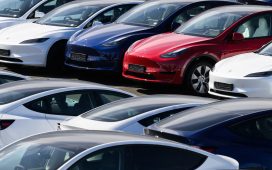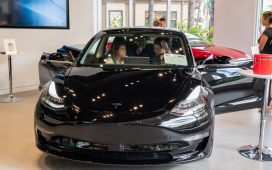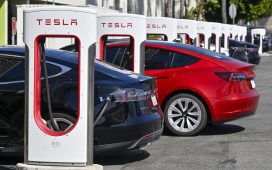Italy’s government is in talks with Stellantis, the carmaker formed by the merger of Fiat Chrysler Automobiles and PSA Group, about investing in electric-vehicle battery manufacturing in the country, according to people familiar with the matter.
A meeting in Rome this week between Stellantis Chairman John Elkann, CEO Carlos Tavares and Giancarlo Giorgetti, Italy’s economic development minister, centered around the future of electric mobility in the country, said the people, who asked not to be named because the gathering was private.
Giorgetti sought assurances from Stellantis that Italy will remain one of the main countries where the company manufactures vehicles and inquired about plans for investment in battery making at Mirafiori, Fiat’s main industrial district in Turin, the people said.
Spokesmen for Stellantis and the minister declined to comment. The discussions are at an early stage, no final decision has been made and the company could decide to invest in battery production elsewhere.
Tricky position
Tavares, 62, is in a tricky position as the head of what is now the second-largest carmaker in Europe, behind only Volkswagen Group.
France recently pressured the former head of Peugeot-maker PSA to maintain engine output that the company was going to move to Hungary. Stellantis executives also have been negotiating with the UK government for months for support to retool a car factory in England in light of the country’s pending combustion-car ban.
PSA was further along in investing in EVs before its merger with Fiat, having made plans for a roughly 5 billion-euro project with oil giant Total that is backed by the French government. PSA’s stronger sales of plug-in hybrids and battery-powered cars enabled Stellantis to exit an emissions-credit agreement that Fiat had set up with Tesla in 2019.
Italian presence
Stellantis employs more than 50,000 workers across several-dozen manufacturing facilities Italy. Last year, the government led by Premier Giuseppe Conte approved a 6.3 billion-euro ($7.7 billion) credit facility for Fiat, the largest government-backed financing arranged for a carmaker in Europe during the coronavirus pandemic.
As part of its green transition push, the new government led by Mario Draghi is planning to invest about 25 billion euros of European Union recovery funds in new infrastructure and top-up that amount with domestic funds for an overall investment of more than 31 billion euros.
The plan calls for renewing the public-transportation fleet with zero- and low-emission vehicles and allocating about 8.5 billion euros to sustainable mobility, including 21,000 public fast-charging stations.
Accelerated shift
Tavares has vowed to speed up Stellantis’s electric shift and forecasts that cars with a battery will account for more than a third of its European sales by mid-decade. The maker of Fiats, Peugeots and Jeeps expects to triple sales of plug-in hybrid and fully electric vehicles to more than 400,000 units this year.
The CEO said last month Stellantis will aim to secure 250 gigawatt-hours of battery capacity by the end of the decade. Decisions to develop additional battery factories in Europe and North America could be made this year, and the company has scheduled a briefing for investors on its EV strategy for July 8.
Fiat has been making cars at its iconic Mirafiori plant since 1939. Mirafiori already has been a hub for the company’s EV production, starting with the electric version of the Fiat 500. Stellantis plans to start producing electric versions of Maserati’s Gran Turismo and Gran Cabrio models in Turin in mid-2022.








